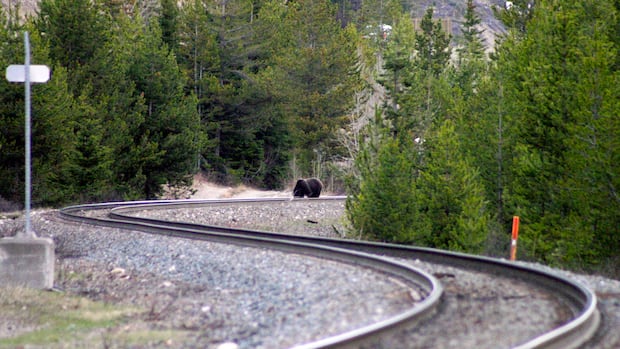It’s a helpless feeling, hitting an animal with a train.
Coming around a corner and seeing an animal with its head down on the tracks, Jim Atkinson, a retired locomotive engineer, says he would do everything he could to try to save its life.
Sometimes it worked; other times it didn’t.
“My natural instinct is to turn that bright headlight off and start blowing on the whistle,” he said.
WATCH | Bears on the tracks: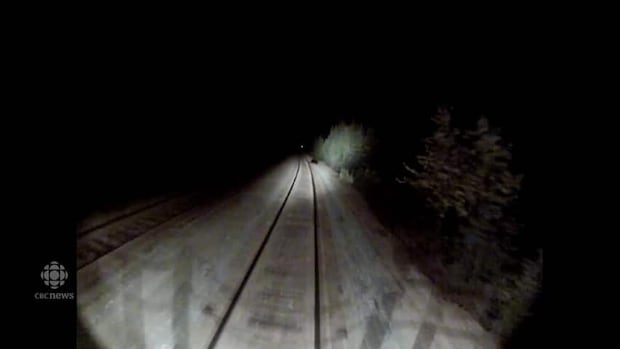 A camera the locomotive of a CP train captures a bear on the tracks
A camera the locomotive of a CP train captures a bear on the tracks
Atkinson started with Canadian National (CN) in 1974 and spent most of his career on a route from Jasper, Alta., to Blue River, B.C., where he would see all sorts of wildlife, including elk, deer and bears. Over the years, the animals he hit stuck with him.
“Sometimes, you’ll hear the animal go underneath the locomotive,” he said, adding that it was the worst when animals were hit by the train but didn’t die right away.
“Those animals sometimes sit there for quite a while injured before somebody euthanizes them.”
Wildlife scientists say railways are natural animal corridors because they offer clear and easy movement. But the average freight train needs at least two kilometres to stop, according to CN, making it impossible to avoid collisions if animals don’t move off the tracks.
The Narwhal, in partnership with the CBC, wanted to find out what is happening to animals on B.C.’s railways.
Documents obtained by The Narwhal through freedom of information requests to the B.C. government and shared with CBC News feature hundreds of reports about collisions between wildlife and trains in B.C. from Canada’s two biggest railways, CN and Canadian Pacific Kansas City (CPKC).
But The Narwhal discovered inconsistencies and gaps in the data that make it difficult to understand the full scope of the issue. Scientists and advocates say if the information was more complete and accessible, it would help them to work with railways to reduce the number of animals killed in areas where collisions happen most often.
The numbers
CPKC said in a statement that its train crews report animal strikes to its operation centre.
According to the statement, “incidents involving grizzly bears or other notable species in national parks are shared with Parks Canada while relevant information is also communicated to the B.C. provincial government for strikes within the province.”
WATCH | Railway collisions are killing B.C. wildlife. These people are trying to reduce them: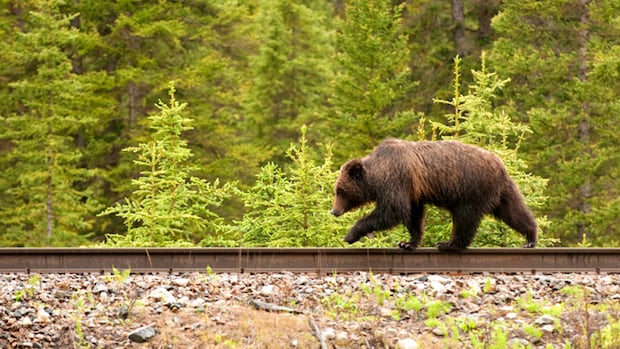
Railway collisions are killing B.C. wildlife. These people are trying to reduce them
Bears and other wildlife are regularly being killed in collisions with trains in B.C. In partnership with The Narwal, CBC’s Jackie McKay breaks down the the efforts to lower that number.
This story was produced in partnership with The Narwhal, through working with the Global Reporting Centre at the University of British Columbia as part of its reporting collaboration on the rail industry led by the Howard Center for Investigative Journalism.
CN told CBC News that when a train hits an animal, the crew reports it to the rail traffic controller, who completes a questionnaire that’s followed up on internally.
“Externally, CN submits an annual report to the [B.C.] Ministry of Environment early each year, outlining all wildlife collisions reported during the previous year,” CN said in a statement.
CN reported 340 wildlife collisions between 2020 and 2023, according to freedom of information documents released to The Narwhal and shared with CBC. These numbers include 202 collisions involving moose and 67 involving bears.
The government released 350 pages of documents showing that CPKC reported no less than 182 animals were killed and injured by trains in the Kootenay region of B.C. in 2022 and 2023.
These CPKC reports show trains collided with at least 90 elk, 49 deer, 18 black bears, and eight grizzlies in those two years.
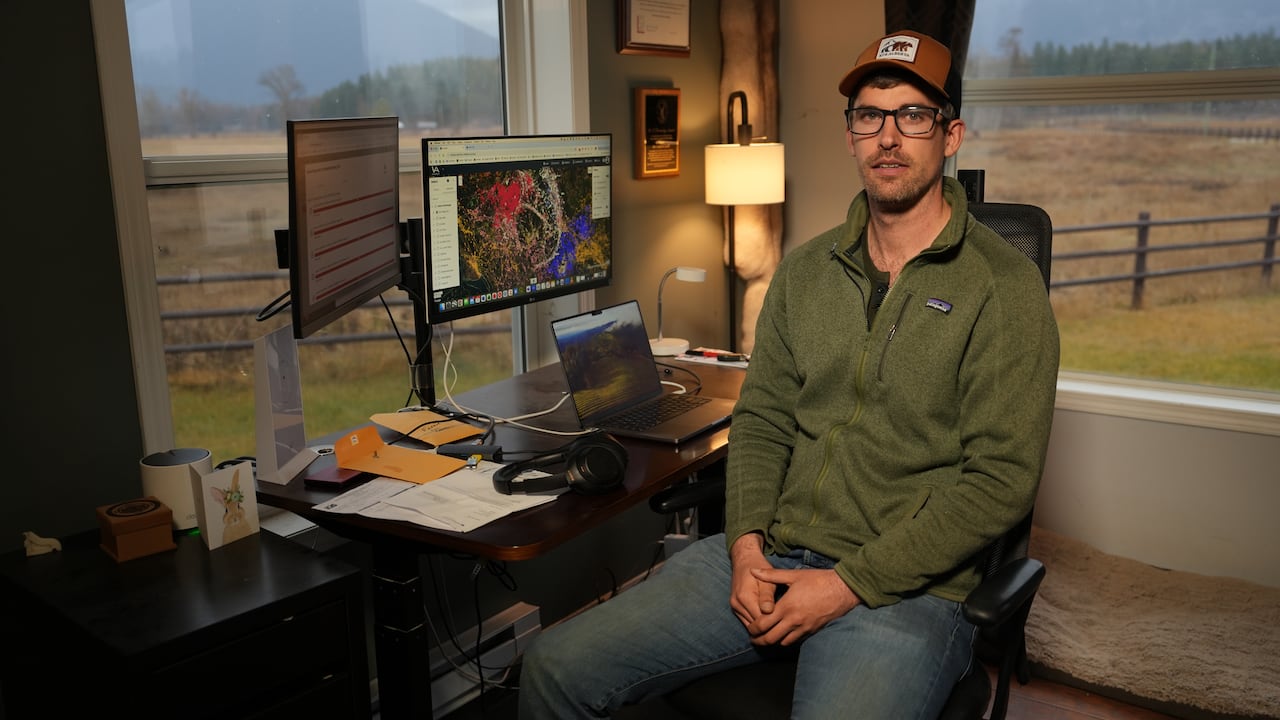 Clayton Lamb, a scientist with Biodiversity Pathways, seen in his home office near Jaffray, B.C., has been tracking wildlife in B.C.’s Elk Valley since 2013. (Monty Kruger/CBC)
Clayton Lamb, a scientist with Biodiversity Pathways, seen in his home office near Jaffray, B.C., has been tracking wildlife in B.C.’s Elk Valley since 2013. (Monty Kruger/CBC)
“It has a pretty huge effect on grizzly bear populations at a population level … it just feels completely unacceptable,” said Clayton Lamb, a scientist with Biodiversity Pathways, a non-profit organization that conducts wildlife monitoring.
For its part, the B.C. Ministry of Water, Land and Resource Stewardship told CBC News in a statement that it is “actively working with railways to improve data collection.”
It also said it is “working to collate all provincially available data for rail-wildlife collisions and to make data collection more efficient and streamlined going forward.”
Family of grizzlies killed in rail strike
Lamb has been tracking wildlife in the Elk Valley since 2013 using collars to determine their movements.
He recently returned to a spot in the valley below a rail trestle where in 2022, he discovered the carcasses of a grizzly bear and its three cubs struck by a train near Elko, B.C.
“It was pretty shocking to come here and find four dead grizzly bears,” he said.
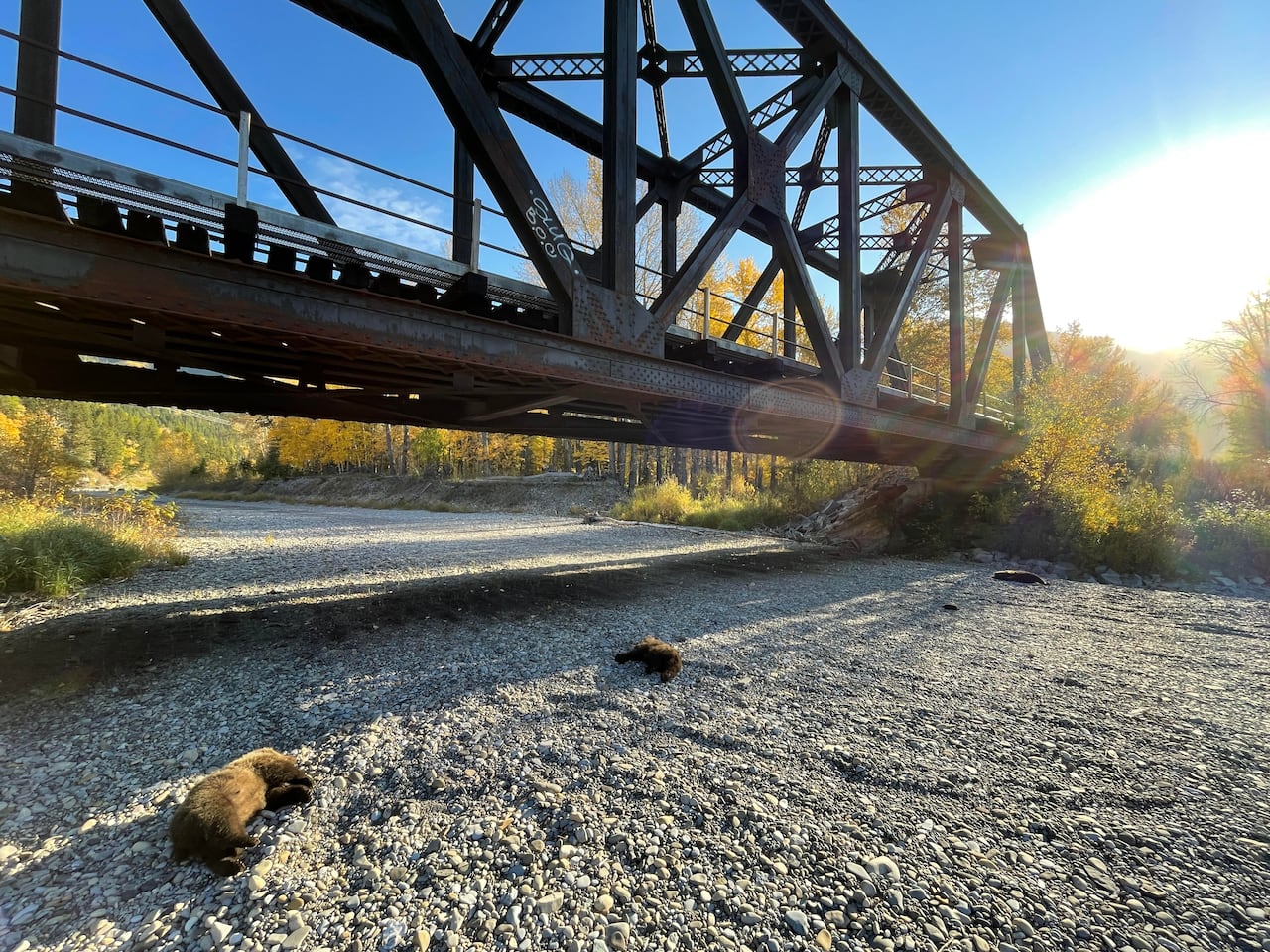 Dead bear cubs are seen under a rail bridge in 2022 after being struck by a train in B.C.’s Elk Valley. (Clayton Lamb)
Dead bear cubs are seen under a rail bridge in 2022 after being struck by a train in B.C.’s Elk Valley. (Clayton Lamb)
Sometimes, grain spilling from passing rail cars attracts animals like deer or elk. If they’re hit, their carcasses can attract other animals, such as bears, creating what Lamb calls a “mortality cycle.”
Bears and other wildlife are on the tracks mainly because they make good walking paths, Lamb says, particularly in the winter when snow is cleared from the tracks.
“They are good movement corridors, for better or worse.”
But when a train comes, Lamb says, animals often choose the clearest path: the one right in front of them.
“They think they can outrun the train, and it just overtakes them.”
WATCH | Damage to ‘grizzly tough’ bear collars: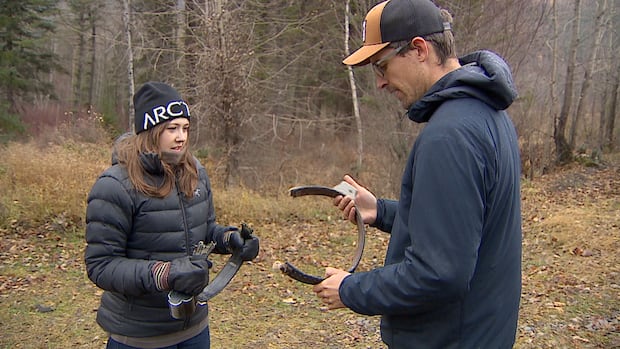
Bear collars are ‘grizzly tough,’ says wildlife scientist
Wildlife scientist Clayton Lamb shows CBC reporter Jackie McKay two kevlar bear collars that broke when the animals wearing them were hit by a train in B.C.
Elk Valley is particularly dangerous for bears, says Lamb.
“Almost half of all the reported railway collisions on grizzly bears in British Columbia occur right here,” he said.
It’s not an issue that needs to be fixed over every kilometre of railway in the province, he said, but could make a huge difference in problem areas like this one.
“It’s probably not gonna be very expensive to mitigate some of these hot spots.”
Solutions to rail collisions
Colleen St. Clair, a biologist at the University of Alberta in Edmonton who has conducted research on how to reduce wildlife and train collisions in Banff National Park, says her work shows that the top contributor to wildlife deaths on railways is train speed. And the best thing trains can do is slow down.
Reducing train speed overall isn’t necessary, she says, but slowing down in areas where wildlife collisions are known to occur “would be a manageable expense relative to, say, erecting fencing and crossing structures.”
St. Clair was also part of a team that developed a warning system to alert animals that trains are coming.
The device was part of a pilot project in Banff National Park in 2017, when there was concern about the number of grizzlies being hit there.
WATCH | Train strikes are killing grizzlies in Banff National Park:
Trains kill 3 grizzlies so far this year in Banff National Park
Parks Canada has confirmed that three grizzly bears have died as a result of being hit by a train. That has one conservationist and well-known wildlife photographer calling for more to be done to protect the animals.
The device, which is about the size of a shoebox, sticks to the train tracks. Sensors detect when a train is about 30 seconds away and set off an alarm with flashing lights.
Smaller animals cleared the track 3.5 seconds faster when the warning device was present, according to St. Clair’s research, while larger animals, those about the size of a coyote or bigger, cleared the track about 6.5 seconds faster with the warning.
“That six seconds could easily make the difference between being struck by a train or not,” she said.
The warning system was removed after the pilot project ended. St. Clair says it requires a lot of maintenance because it’s battery operated, and the “cost-benefit” may not be worth it for the railway companies right now.
WATCH | How the bear warning device works: A bear warning system flashes light and sound to give grizzly bears frequenting the track a 30-second alert to get off the track.
A bear warning system flashes light and sound to give grizzly bears frequenting the track a 30-second alert to get off the track.
CN said in a statement that it is “actively evaluating a range of detection, monitoring and mitigation technologies” meant to reduce wildlife collisions and that its approach is informed by data, best practices and input from experts.
In a statement, CPKC said its strategies include clearing vegetation along the tracks to reduce the number of animals attracted to the area and give wildlife the space to leave the tracks.
CBC News reached out to B.C.’s Ministry of Water, Land and Resource Stewardship to find out why the warning system isn’t being used. The Ministry suggested asking Transport Canada. Transport Canada declined to respond and suggested asking the railway companies directly.
To force railways to adopt changes that would reduce deaths would require “a very broad societal agreement” that wildlife deaths by train are unacceptable, St. Clair said.
“And we don’t have that currently.”
Cultural impacts
When the railway first appeared in Elk Valley, the people of the Ktunaxa Nation called it the “iron horse,” said Kyle Shottanana, an elected councillor of the Yaq̓it ʔa·knuqⱡi’it First Nation (formerly called Tobacco Plains), which covers about 43 square kilometres of southeastern B.C.
 Kyle Shottanana, an elected councillor of the Yaq̓it ʔa·knuqⱡi’it First Nation, says the loss of the animals has cultural impacts on his nation. (Monty Kruger/CBC)
Kyle Shottanana, an elected councillor of the Yaq̓it ʔa·knuqⱡi’it First Nation, says the loss of the animals has cultural impacts on his nation. (Monty Kruger/CBC)
CN is the largest rail operator in B.C., running 4,501 kilometres of track, while CPKC operates 2,977 kilometres. Trains transporting goods to and from the West Coast often cut into the remote wilderness of the Ktunaxa Nation, which includes the Yaq̓it ʔa·knuqⱡi’it First Nation.
Shottanana says that when he was younger, he would walk the tracks looking for antlers. He would also find the carnage of animals struck by trains.
Wildlife collisions aren’t something that most people see or think about, he says, but the loss of the animals has cultural impacts on his nation.
“All of us have a responsibility to take care of the land, the water and the air and the animals.”
LISTEN | How do we manage grizzly bears?:
The Current13:38What’s the best way to manage grizzly bears?
A grizzly bear attacked a school group in a remote Indigenous community in central B.C. last week — and it brought to light an ongoing debate about what the best way to manage and co-exist with grizzly bears is. Some think hunting should be allowed back on the table — others say there’s ways to co-exist with bears safely without resorting to killing them.
Shottanana would like to see a reduction in the number of animals killed by trains and says sharing the details of when and where collisions happen could help.
“It’s easy to point the finger and lay the blame, but I think the real action that is needed is the working together to come up with the solutions.”
Scientists like St. Clair say if the data was public researchers would “absolutely” use it to help railway companies find cost-effective ways to reduce collisions.
“The only thing we really need to be able to do that is very open data about where the collisions occur.”
This story was produced in partnership with The Narwhal, through working with the Global Reporting Centre at the University of British Columbia as part of its reporting collaboration on the rail industry led by the Howard Center for Investigative Journalism.

